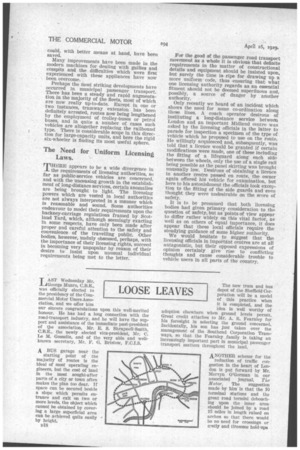The Need for Uniform Licensing Laws.
Page 88

If you've noticed an error in this article please click here to report it so we can fix it.
THERE appears to be a wide divergence in the requirements of licensing authorities, so far as public-service vehicles are concerned, and with the unceasing growth in the establishment of long-distance services, certain anomalies are being brought to light. The licensing powers which are vested in local authorities are not always interpreted in a manner which is reasonable and sound. Some authorities endeavour to model their requirements upon the hackney-carriage regulations framed by Scotland Yard, which, although seemingly exacting in some respects, have only been made after proper and careful attention to the safety and convenience of the travelling public. Other bodies, however, unduly obsessed, perhaps, with the importance of their licensing rights, succeed in becoming very unpopular by reason of their desire to insist upon unusual individual requirements being met to the letter. For the good of the passenger road transport movement as a whole it is obvious that definite requirements in the matter of constructional details and equipment should be insisted upon, but surely the time is ripe for drawing up a more uniform code, thus ensuring that what one licensing authority regards as an essential fitment should not be deemed superfluous and, possibly, a source of danger by another authority.
Only recently we heard of an incident which shows the need for some co-ordination along these lines. A coach operator desirous of instituting a long-distance service between London and an important Midland centre was asked by the licensing officials in the latter to parade for inspection a specimen of the type of vehicle which he proposed to use on the route. He willingly acquiesced and, subsequently, was told that a licence would be granted if certain modifications were made, one of these including the fitting of a lifeguard along each side between the wheels, only the use of a single rail being possible as the panel skirting was brought unusually low. Desirous of obtaining a licence in another centre passed en route, the owner again offered hi S vehicle for examination, but here to his astonishment the officials took exception to the fitting of the side guards and even thought they were undesirable on the score of safety, It is to be presumed that both licensing bodies had given primary consideration to the question of safety, but as points of view appear to differ rather widely on this vital factor, as well as on others of equal importance, it does appear that these local officials require the steadying guidance of some higher authority.
We would hesitate to suggest that the licensing officials in important centres are at all antagonistic, but their opposed expressions of opinion certainly give rise to conflicting thoughts and cause considerable trouble to vehicle users in all parts of the country.








































































































































































































